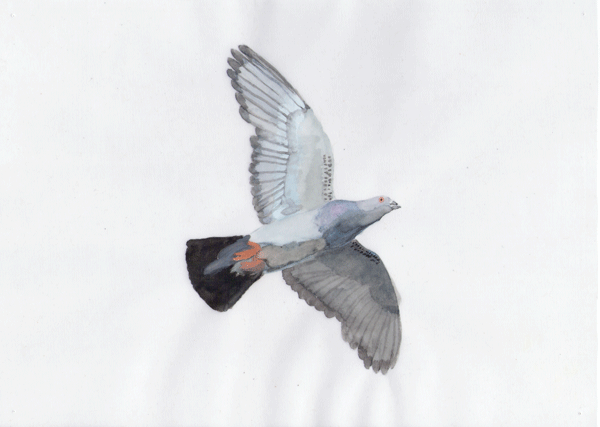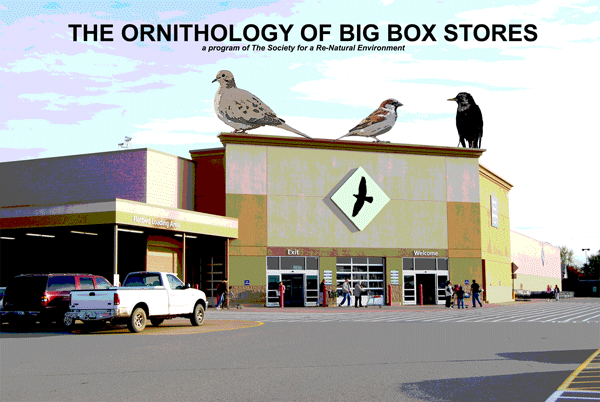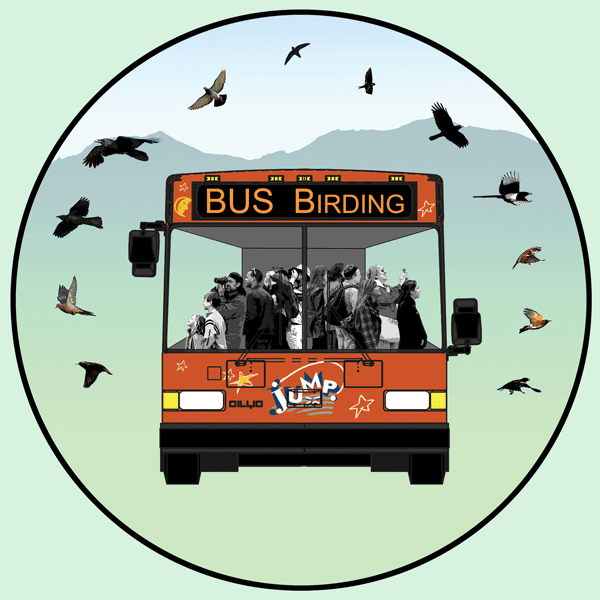Bird Shift: The Anthropogenic Ornithology of North America
is an exhibition created by Brian D. Collier in collaboration with Boulder-based scientists, transportation specialists, bird watchers, and others.
“Bird Shift” is commissioned by EcoArts Connections and co-presented by EAC and the CU Museum of Natural History. It will be exhibited at the Museum's BioLounge, August 22-December 31, 2011.
Bird Shift will explore how human activities influence bird behavior in Boulder County, including shifting ranges due to climate change. The exhibit will include photos, objects, video, text, and print and web-based elements. In addition, there will be a series of talks, panel discussions, bird walks, a bird-themed poetry reading, a barn swallow science stop, family activities, and other events held in conjunction with the exhibition.
There are four major components of the Bird Shift exhibition.
"The New Birds of Boulder County” will include a large wall map mural showing birds that have become extirpated, and birds that have been introduced or have shifted their range and behavior in Boulder County post-European colonization.
"Explorations of a Re-Natural Bird Sanctuary" will investigate the rich bird habitat that has developed at the Valmont coal-fired power plant because of the warm cooling ponds.
"The Ornithology of Big Box Stores" will offer surprising solutions for birds that live in warehouse stores and for the store owners who might otherwise want to evict them.
“Bus Birding” is a new art/science/transportation project created for the Long JUMP bus route in Boulder County designed to encourage ridership and help bus riders learn about local birds.

Bird Shift: The Anthropogenic Ornithology of North America is a series of projects that look at various ways humans have affected populations and behaviors of North American birds since European colonization. Through our direct and indirect actions, the very definition of the phrase “North American Birds” is changing.
Factors including anthropogenic climate change are predicted to have a huge impact on bird populations in the coming decades. The U.S. government publication, The State of the Birds 2010 Report on Climate Change states,
Birds in every terrestrial and aquatic habitat will be affected by climate change, although individual species in each habitat are likely to respond differently.
Although many factors are known to drive range changes, results from the Christmas Bird Count (CBC) show that the warmer winters in recent decades have played an important role in shifting winter bird ranges to the north.
Forecasts of bird extinction rates depend on the potential resilience of ecosystems, and vary from 5 per cent to over 70 per cent, based on current emission and warming trajectories.
These predictions are troubling, and we will certainly mourn the loss of some species. At the same time, there will be outcomes other than loss, points too interesting to overlook. These include the expansion of bird ranges into new territory, the ongoing migration of species through their introduction into different areas by humans, and a potential increase in diversity within some of our local bird communities.
The central idea I've taken away from my investigations is how intimately connected we are to birds. Our daily decisions about where we live, what we eat and how we travel affect them more than we tend to realize. Yet it's not hard to see how they're adapting to our influential presence when we take some time to look around.

The New Birds of Boulder County represents one way to visualize these changes, juxtaposing living birds to preserved specimens. I chose photos of birds in flight as sources for my drawings of the new birds. I did my drawings of extirpated and declining birds from specimens I photographed in the bird collection at the University of Colorado Museum of Natural History.
Explorations of a Re-Natural Bird Sanctuary
During my first visit to Boulder to work on this exhibition, I was taken to the National Audubon Society's Important Bird Area at the nearby Xcel Energy Valmont Power Station. I immediately became interested in it as an example of what I call a “re-natural” environment.
Re-natural environments are sites where wild plants and animals exist in significantly human-altered habitats, or where they're actively re-inserting themselves into these altered spaces. These sites are found in urban, suburban, industrial, and large-scale agricultural landscapes. The plants and animals here are often a mix of native and exotic species; they're in the process of striking a new ecological balance in the wake of (often destructive) human habitat transformation.
Although the power station is an active industrial site, a remarkably large and diverse bird community can be found in and around the man-made reservoirs, mostly in the winter months. This is due in great part to the artificially warmed water from the coal-fired generator at the power plant. Another significant factor is the restriction of human access to this area. The site has developed into a fine re-natural environment with a relatively undisturbed, diverse community of plants and animals.
Things are about to change at the Valmont site. The coal-fired generator responsible for the unnaturally warm water is going to be shut down by 2017, perhaps sooner. We can't know exactly how this change will affect the animal and plant communities now living at Valmont. What we can do is to observe it, with the awareness that a specific kind of human intervention is ending and this re-natural environment will have to recreate itself all over again.
The photos and video for this exhibition were taken by me during four separate exploratory trips to the site in 2010 and 2011.

The Ornithology of Big Box Stores
As wild animals continue to adapt to life in extensively human-altered habitats, The Society for a Re-Natural Environment seeks to uncover examples of their adaptation. It then creates strategies for reimagining coexistence in order to benefit non-human animals, as well as the human animals who encounter them.
To this end we present an investigation of the wild birds that visit big box stores, sometimes taking up residence in and around them. We also developed a plan to shift this phenomenon from a perceived negative into a potential positive: rather than viewing birds as nuisances, consumers can take pleasure and interest in their avian neighbors.
Our proposal hatched from the belief that today's big-box shopping experience has great untapped potential. What if we combine shopping with an activity akin to bird watching, going on a nature walk, or visiting an aviary at a zoo? Our proposed Bird-Enhanced Stores, or “Big Box Aviaries,” offer a non-destructive way for companies to manage their existing bird populations while establishing a more stimulating environment for their customers.

Bus Birding is a new art-nature-transportation project created for the Long JUMP route that runs primarily along Arapahoe Avenue in Boulder County. It transforms buses and bus stops into bird watching sites for the bus riding community and novice bird watchers. Two equally important goals drive the project. The first is to inspire people to ride the bus. The second is to help them become better acquainted with the surprising number and variety of birds that live all around us.
